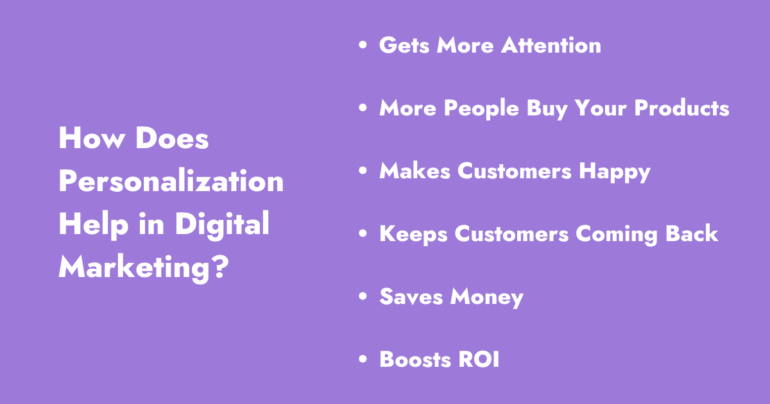When we talk about digital marketing and growth, we’re talking about getting personal. It’s like when you walk into your favorite coffee shop, and the barista knows your order by heart. That feels good, right?
That feeling is exactly what businesses aim for with personalization in digital marketing. It’s about making every single customer feel like they’re the only one in the room, recognized and valued. So, how about we jump into this together? We’ll explore the magic of personalization, share some handy tips for making your digital marketing feel more personalized, and peek at how some brands are nailing it.
How Does Personalization Help in Digital Marketing?
According to Segment,
“52% of consumers say that the more personalized their digital interactions with brands are, the happier they are.”
How do you feel when you open an email and it seems like it’s written especially for you? The recommendations they provide make you feel understood as if they know exactly what you love. That’s the concept of personalization. Imagine you bought trousers from Zara, and the brand keeps sending you clothing recommendations that align with your taste. You enjoy this because it’s clear they understand your preferences.
It’s like when Netflix shows you a list of movies you might like. They do this by looking at what you’ve watched before and guessing what else you might enjoy. There’s more happiness with Netflix when you watch more.

Personalization Strategies in Digital Marketing
Want to implement user-centric marketing strategies to boost your business and establish strong relationships with your customers? Here are some personalization strategies in digital marketing for the US audience.
- Data-Driven Personalization
In e-commerce, it is a very common practice to suggest items based on what you have viewed or added to your cart. For example, Amazon is a master at data-driven personalization. Ever notice how, after you look at something on Amazon, you start seeing suggestions for similar items? Amazon keeps track of what you like and uses that info to show you other things you might want to buy. It’s like having a friend who knows your taste in books or gadgets and makes spot-on recommendations. This smart guessing game helps Amazon sell more because it makes shopping easier and more fun for you.
Or another great brand — Starbucks. The mobile app provides a highly personalized experience by remembering favorite orders, suggesting new products based on past purchases, and allowing users to customize their drinks. This level of personalization has not only increased sales but also enhanced customer loyalty.
- Customer Segmentation
To boost customer engagement, you must consider customer segmentation — divide your audience into groups based on their demographics, interests, or behaviors. For example, Nike excels in using client segmentation in their digital marketing. Initially targeting professional athletes, Nike expanded its focus to include everyday athletes and sports enthusiasts. By analyzing the benefits of its products, Nike identified a target market of younger consumers interested in fitness who have disposable income for sports equipment. This approach allows Nike to tailor its marketing strategies to motivate and include aspiring athletes and runners, making their campaigns more effective and inclusive.
- Interactive Video Messages
Create interactive videos where viewers can make choices. This could be used for product demos, tutorials, or brand storytelling.
For example, you could watch a video about a new phone and pick which parts you want to learn more about, like the camera or the battery. You choose what you want to see, and that’s what the video shows. You can have fun while learning about things before you buy them.
- Augmented Reality (AR) Shopping Experiences
One of the customized marketing strategies is using AR to allow customers to see how products would look in their own space or on them. Use AR filters to let customers design their own product packaging or see how customizable elements would look on products in real-time.
For instance, a furniture brand could let customers visualize how a couch looks in their living room before buying.
- Voice-Activated Content
One of the digital marketing trends is voice-activated content. Develop content that can be navigated or personalized through voice commands. This could include podcasts that adapt topics based on listener input or interactive voice-responsive web pages. Here’s how to make it work well:
- Podcasts That Adapt
Create podcasts where listeners can change the topic with a simple voice command. Use keywords related to each segment for the voice system to recognize and navigate the content accurately.
- Websites That Listen
Build web pages that respond to voice commands for easier navigation, like moving through a recipe step-by-step or searching for products on an e-commerce site. Keywords in the web content help match user commands to the right actions.
Key Tips for Voice-Activated Content
- Use Keywords: Embed relevant keywords throughout your content to improve voice command detection.
- Understand User Intent: Think about how users might use voice commands with your content and prepare accordingly.
- Integrate Technology: Apply voice recognition tools that can process commands and respond with the correct content.
- Gather Feedback: Collect user input to refine your voice features and improve the overall experience.
For example, Spotify is a great example of a business that uses voice-activated content. Voice instructions have been seamlessly added, which improves the user experience by making it easier to find music and play it.
- Gamified Personalization Quizzes
Design quizzes that not only entertain but also gather insights about preferences, leading to personalized product recommendations. This could be themed around personality types, style preferences, or product needs.
Quizzes, polls, and interactive infographics can provide personalized results or insights, making your content more engaging and tailored to the individual user.
- Marketing Automation
Marketing automation means using tools to send custom messages automatically based on what users do or when they reach certain goals. Automated birthday or wedding emails can be sent by email marketing tools like Mailchimp. This makes exchanges with customers feel more personal.
At this point, Starbucks does a very good job of sending personalized emails. They’ll give you something free on your birthday if you’re in their rewards program.
- Customizable Avatars for Online Shopping
Let customers create avatars that match their body type and preferences to try on clothes virtually, providing a more personalized and engaging shopping experience.
- Making Ads That Don’t Annoy People
Ads may bother you, but they don’t have to. Let’s look at Spotify. They tell you about new sets and songs to listen to based on what you’ve already heard. That way, if you like jazz, you won’t get a lot of heavy metal ads all of a sudden. It sounds more like a friend sharing songs they know you’ll like than an ad. It makes music more fun to listen to, and you might find a new favorite song or singer that way.
What’s the big picture? With personalization, marketing should feel less like yelling into the void and more like a chat between friends. You want to show your customers that you know what they like and care about it. That makes customers happy, and it also helps brands make more sales and keep customers coming back.
What’s cool about that? Making things more unique will only get smarter as technology gets better. We can now look forward to a time when digital marketing feels even more personalized, like going to your favorite coffee shop online.
Personalization in digital marketing works out well for everyone in the end. Customers have a better time shopping online when they feel like they are understood and valued. Brands also gain because customers who are happy and loyal are more likely to come back. Personalization is what makes your digital world a little more about you. Keep that in mind the next time you get a suggestion that feels just right.




